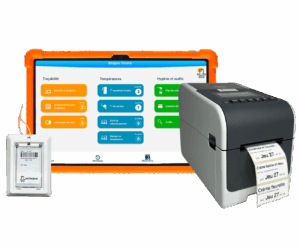What is traceability in the food service industry?
Traçabilité
⏳ Temps de lecture : 5 min
? Mis à jour le : 29/10/2024
Traceability in Food Service: Why Is It So Important? 🍽️
In their restaurant, the restaurateur must be able to ensure food traceability. That is, to be able to “trace the journey of a food product through all stages of production, processing, and distribution.” 🍴
Traceability in restaurants is a regulatory obligation linked to the HACCP method. The Regulation (EC) No. 178/2002 of the Hygiene Package defines, among other things, the traceability obligations for restaurateurs.
What are the steps to guarantee traceability in your restaurant? 🍽️
Ensure inspection upon receipt: that is, check the goods at delivery. This is upstream traceability. We recommend keeping delivery notes detailing all received goods. 📋
The Octopus HACCP app allows you to carry out your receipt inspection in just a few clicks from your mobile, and to record essential information (delivery identification, compliance with temperatures and best-before/use-by dates, digital saving of the delivery note). 📱
Keep the information on product labels: this step takes place when using and processing goods. This is internal traceability.
Octopus HACCP lets you take photos of all your traceability labels from your mobile or tablet. 📸 This allows you to keep essential information (product name, batch number, expiration date, health stamp) with a single click. You thus avoid storing bulky paper archives in your restaurant office.
In case of a health inspection, you will be able to easily find your product traceability photos by searching by date.
How long should I keep traceability labels in my restaurant? 🕒
You can also free up storage space in your office! With Octopus HACCP, it is not necessary to keep paper traceability labels to comply with regulations.
Label the unpackaged products you store in your restaurant.
When you unpack a product that you will store in a cold room, you must apply a new HACCP label.
This labeling allows you to know the unpacking date and the maximum shelf life of the product. In the absence of microbiological analysis, this shelf life is 3 days. Some very sensitive products have shorter shelf lives, such as ground meat, fresh fish, liquid eggs, etc. But some products may have a longer shelf life, such as stabilized mayonnaise, mustard, unsliced dry-cured ham, etc. In this case, the shelf life after opening is indicated on the product packaging. ?
Octopus HACCP allows you to label your products with one click from your smartphone, without making mistakes on the secondary expiration date! ?
How to label preparations made within my restaurant? ?
When you make a preparation, raw or cooked, such as a sauce, a cooked dish, mise en place, or assembly, you must also label your preparation.
For preparations, the rule is the same as for unpackaged products: a maximum shelf life of 3 days in the absence of microbiological analysis. If you have microbiological analyses carried out by a laboratory to determine the shelf life of your products, you may obtain longer shelf lives. ⏳
Vacuum-packed products can have longer shelf lives, but the regulations do not provide guidance for these specific cases. In this case, you should refer to the good hygiene practices guide of your sector or ask your vacuum machine supplier for advice.
Storage temperature is also important and should be a maximum of 3°C for your preparations. Note that ground meat and fresh fish must be stored at a maximum of 2°C. ?
It is important to properly label each product stored in the cold room. During a sanitary inspection, the inspector will ensure you do not have expired products in your cold storage. If a product is not labeled, it is impossible to know its expiration date. Be especially vigilant with sensitive products: meats, fish, dairy products, etc. ❄️
In summary: it is essential to guarantee traceability within your restaurant. Along with the general hygiene of your establishment, traceability is one of the crucial points during a hygiene inspection.
Would you like to learn more about this topic? Check out our article to better understand the HACCP method.




